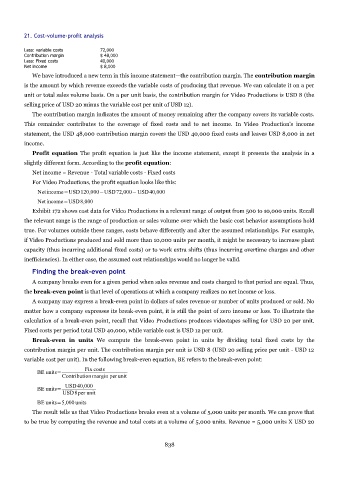Page 837 - Accounting Principles (A Business Perspective)
P. 837
21. Cost-volume-profit analysis
Less: variable costs 72,000
Contribution margin $ 48,000
Less: Fixed costs 40,000
Net income $ 8,000
We have introduced a new term in this income statement—the contribution margin. The contribution margin
is the amount by which revenue exceeds the variable costs of producing that revenue. We can calculate it on a per
unit or total sales volume basis. On a per unit basis, the contribution margin for Video Productions is USD 8 (the
selling price of USD 20 minus the variable cost per unit of USD 12).
The contribution margin indicates the amount of money remaining after the company covers its variable costs.
This remainder contributes to the coverage of fixed costs and to net income. In Video Production's income
statement, the USD 48,000 contribution margin covers the USD 40,000 fixed costs and leaves USD 8,000 in net
income.
Profit equation The profit equation is just like the income statement, except it presents the analysis in a
slightly different form. According to the profit equation:
Net income = Revenue - Total variable costs - Fixed costs
For Video Productions, the profit equation looks like this:
Netincome=USD120,000−USD72,000−USD40,000
Netincome=USD8,000
Exhibit 172 shows cost data for Video Productions in a relevant range of output from 500 to 10,000 units. Recall
the relevant range is the range of production or sales volume over which the basic cost behavior assumptions hold
true. For volumes outside these ranges, costs behave differently and alter the assumed relationships. For example,
if Video Productions produced and sold more than 10,000 units per month, it might be necessary to increase plant
capacity (thus incurring additional fixed costs) or to work extra shifts (thus incurring overtime charges and other
inefficiencies). In either case, the assumed cost relationships would no longer be valid.
Finding the break-even point
A company breaks even for a given period when sales revenue and costs charged to that period are equal. Thus,
the break-even point is that level of operations at which a company realizes no net income or loss.
A company may express a break-even point in dollars of sales revenue or number of units produced or sold. No
matter how a company expresses its break-even point, it is still the point of zero income or loss. To illustrate the
calculation of a break-even point, recall that Video Productions produces videotapes selling for USD 20 per unit.
Fixed costs per period total USD 40,000, while variable cost is USD 12 per unit.
Break-even in units We compute the break-even point in units by dividing total fixed costs by the
contribution margin per unit. The contribution margin per unit is USD 8 (USD 20 selling price per unit - USD 12
variable cost per unit). In the following break-even equation, BE refers to the break-even point:
Fix costs
BE units=
Contribution margin perunit
USD40,000
BE units=
USD8per unit
BE units=5,000 units
The result tells us that Video Productions breaks even at a volume of 5,000 units per month. We can prove that
to be true by computing the revenue and total costs at a volume of 5,000 units. Revenue = 5,000 units X USD 20
838

